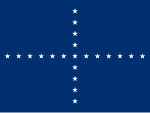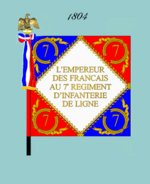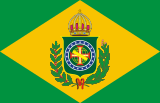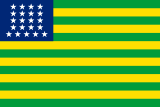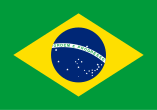Flag of Brazil
| Flag of Brazil | |
|---|---|
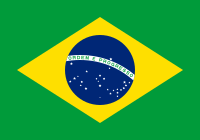 |
|
| Vexillological symbol : |
|
| Aspect ratio: | 7:10 |
| Officially accepted: | Basic design: November 19, 1889 Current shape: May 11, 1992 |
The flag of Brazil shows a yellow diamond on a green background.
The colors do not originally represent the green of the vast primeval forests and the numerous mineral resources (yellow) of the country. Rather, green is the color of the House of Braganza , yellow that of the Habsburgs .
description
The blue area in the diamond represents the sky over Rio de Janeiro on November 15, 1889 at 8:30 a.m. - the place and time of the proclamation of the republic. The image is inverted, as if the viewer were outside the celestial sphere and were looking at Brazil through the constellations arranged on it. The 27 stars stand for the 26 states of Brazil and the federal district . Their number increased from 21 (1889–1960) through 22 (1960–1968) and 23 (1968–1992) to 27 stars (since 1992).
The Portuguese motto ordem e progresso [ɔɾdeĩ i pɾu'gɾɛsu] ( order and progress ) of the white banner goes back to the French Auguste Comte , whose philosophy (the positivism ) adhered to the founding fathers of the republic.
Colours
The colors of the flag are not included in any legal document. Approximate colors are listed below.
| colour | green | yellow | blue | White |
|---|---|---|---|---|
| RGB | 0/168/89 |
255/204/41 |
62/64/149 |
255/255/255
|
| HEX | 00A859 |
FFCC29 |
3E4095 |
FFFFFF
|
| CMYK | 100/0/100/0 |
0/20/100/0 |
100/100/0/0 |
0/0/0/0
|
| Pantone | Green 355 C |
Yellow C |
Blue 280 C |
White
|
history
On the occasion of the declaration of independence from Portugal, the Brazilian Empire adopted a green flag with a yellow diamond on September 18, 1822, the corners of which touched the edge of the flag. The diamond arrangement, which is unusual in vexillology, is said to have been modeled on French regimental flags from the First Empire .
The colors of the flag go back to the Brazilian Emperor Pedro I , who associated green, the color of his house (Bragança), with the yellow of the Habsburgs on the occasion of his marriage to Maria Leopoldine of Austria . A crowned green shield appeared in the center of the flag, surrounded by branches of green coffee and tobacco. On the shield was a white disc with the crimson cross of the Order of Christ in the center. December 1822 the emperor's coat of arms was placed in the middle of the flag.
In 1889 the last Brazilian emperor ( Pedro II ) was overthrown. The republic replaced the imperial coat of arms on the flag with a blue celestial sphere with the stars of the southern sky, crossed by a white ribbon bearing the inscription Ordem e progresso . The stars on the flag represent the sky over Rio de Janeiro on November 15, 1889, the place and time when the Republic was proclaimed. The yellow diamond on the green area has also been reduced to its current size.
The current representation of the flag was adopted by Flag Act number 8421 on May 11, 1992.
Flag of the Kingdom of Brazil in the United Kingdom , 1816 to 1822
Stars
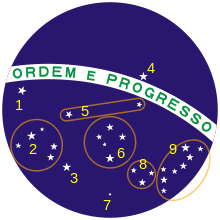
1. Prokyon (α Canis Minoris )
2. Big Dog
3. Canopus (α Carinae )
4. Spica (α Virginis )
5. Water snake
6. Southern Cross
7. Sigma Octantis
8. Southern Triangle
9. Scorpio

| No. | Country | star | Constellation | size |
|---|---|---|---|---|
| 1 | Pará | α Virginis ( Spica ) | Virgin ( virgo ) | 1 |
| 2 | Amazon | α Canis Minoris ( Prokyon ) | Small dog (Canis minor) | 1 |
| 3 | Mato Grosso do Sul | α Hydrae ( Alphard ) | Water snake (hydra) | 2 |
| 4th | acre | γ hydrae | 3 | |
| 5 | Mato Grosso | α Canis Majoris ( Sirius ) | Big dog (Canis Major) | 1 |
| 6th | Amapá | β Canis Majoris ( Murzim ) | 3 | |
| 7th | Rondônia | γ Canis Majoris ( Muliphein ) | 4th | |
| 8th | Roraima | δ Canis Majoris ( Wezen ) | 2 | |
| 9 | Tocantins | ε Canis Majoris ( Adhara ) | 2 | |
| 10 | Goiás | α Carinae ( Canopus ) | Keel of the ship (Carina) | 1 |
| 11 | Bahia | γ Crucis ( Gacrux ) | Southern Cross (Crux) | 2 |
| 12 | Minas Gerais | δ Crucis ( Decrux ) | 3 | |
| 13 | Espírito Santo | ε Crucis | 4th | |
| 14th | São Paulo | α Crucis ( Acrux ) | 1 | |
| 15th | Rio de Janeiro | β Crucis ( Becrux ) | 2 | |
| 16 | Piauí | α Scorpii ( Antares ) | Scorpion (Scorpius) | 1 |
| 17th | Maranhão | β Scorpii ( graffias ) | 3 | |
| 18th | Ceará | ε Scorpii | 2 | |
| 19th | Rio Grande do Norte | λ Scorpii ( Shaula ) | 2 | |
| 20th | Paraíba | κ Scorpii ( Girtab ) | 3 | |
| 21st | Pernambuco | µ Scorpii | 3 | |
| 22nd | Alagoas | θ Scorpii ( Sargas ) | 2 | |
| 23 | Sergipe | ι Scorpii | 3 | |
| 24 | Santa Catarina | β Trianguli Australis ( Betria ) |
Southern Triangle (Triangulum Australe) |
3 |
| 25th | Rio Grande do Sul | α Trianguli Australis ( Atria ) | 2 | |
| 26th | Paraná | γ Trianguli Australis | 3 | |
| 27 | Federal District | σ Octantis ( Polaris Australis ) | Octant (octane) | 5 |
See also
literature
- The Flag Institute (ed.): National flags of the world. Edition Maritim, Hamburg 2000, ISBN 3-89225-402-8 .
- Karl-Heinz Hesmer: Flags and coats of arms of the world. History and symbolism of the flags and coats of arms of all states. Bertelsmann, Gütersloh 1992, ISBN 3-570-01082-1 .
- Jens Soentgen : The Bandeira Brasileira . In: New Aesthetics. The atmospheric and the art, Festschrift for Gernot Böhme . Wilhelm Fink Verlag, Munich 2002, ISBN 3-7705-3639-8 , pp. 153-172.
Web links
- Flags of the world - Brazil (English)
- A Bandeira do Brasil ( Memento of April 22, 2012 in the Internet Archive ), flag of Brazil (Portuguese)
Individual evidence
- ^ Carl D. Goerdeler: The law of happiness . In: Die Zeit , No. 50/2007.
- ↑ Flag of Brazil (see CDR or EPS file)
- ^ Karl-Heinz Hesmer: Flags and coats of arms of the world. Bertelsmann Lexikon Verlag, Gütersloh 1992, p. 34.
